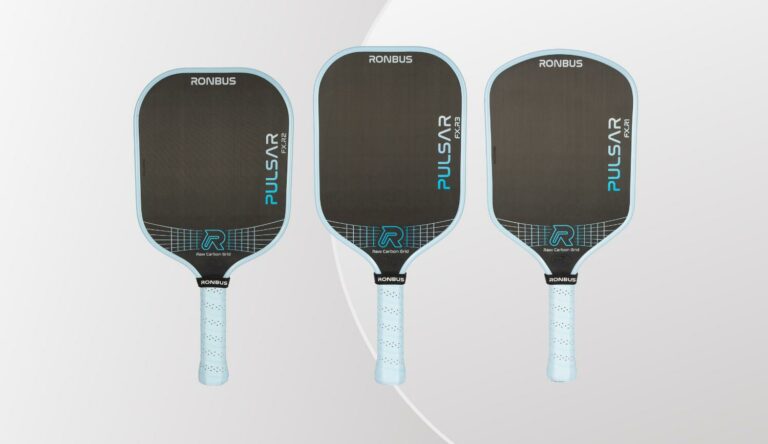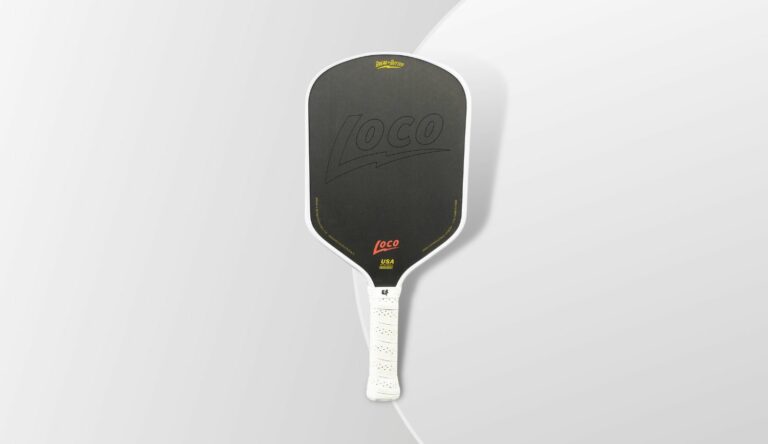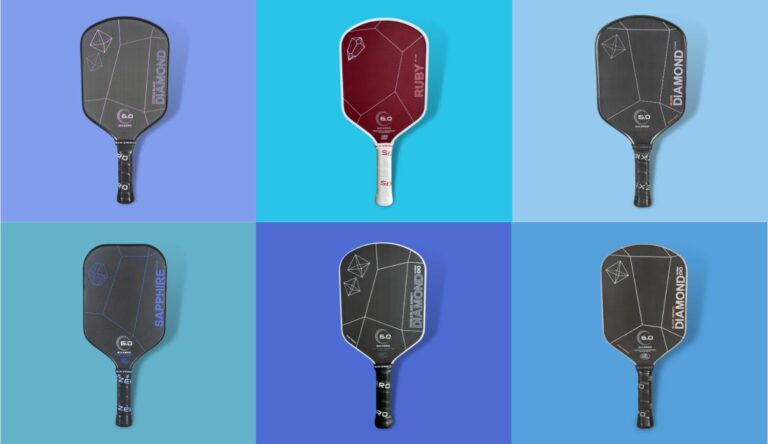Are you trying to understand Pickleball’s rating system? You’re in the right place.
Getting your rating figured out can be key to having a rewarding and fun time playing pickleball, even if you never plan to play in a tournament.
In this article, I’ll be helping you understand:
- How the pickleball rating system(s) work
- Rating level breakdowns
- How to rate yourself in pickleball
- How to get an official rating for tournaments
- How to approach signing up for your first tournament
- And more
Here are key reasons why it’s good to know your rating:
- So you can coordinate play with similarly skilled players
- To enter a tournament at your level and/or find a similarly skilled partner to register for tournaments and events with
Contents
How pickleball rating systems work
When it comes to informal ratings, a lot of groups and clubs use the simplified “beginner, intermediate, and advanced” designations in an effort to organize group rec play.
- Beginner players. These players are all new to pickleball but vary slightly in their previous sports experience. Some players will never have played a sport before, while others are accomplished athletes but are just getting started with pickleball. Beginners are able to hit simple shots and are working to develop a basic understanding of pickleball’s rules and strategies. They often make unforced errors.
- Intermediate players. Intermediate players have a well-rounded understanding of the rules of pickleball and know enough strategy to sustain rallies and employ a wider range of shot selections using strategic placement.
- Advanced players. Advanced players have mastered many of the game’s nuances. They’re patient and can hit most, if not all, shots with spin and precision. They know how to read their opponent’s strengths/weaknesses and execute high-level tailored strategies against them.
And then we have the official rating systems, such as UTPR and DURP. These more precise systems rely on numerical classifications ranging from 1.0 to 5.5+ and are calculated through official assessment and/or tournament results.
Assessment tools, such as the one published by USA Pickleball, can determine a player’s skill based on a variety of factors, including:
- Strategic capabilities (adaptability, consistency, placement, control, control of pace, etc).
- Shot selection/mechanics (forehands, backhands, drops, dinks, volleys, blocks, etc).
- Additional nuanced diagnostics, such as mental composure and physical competence
Self-Rating
To determine their rating, many people follow the route of self-assessment. You’ll need to compete in officially sanctioned tournaments if you want to have an official rating, though. More on self-rating later in this article.
UTPR Rating
The UTPR (USA Pickleball Tournament Player Ratings) rating scale is used as the official rating system for USA Pickleball sanctioned tournaments. An individual can have a unique UTPR score for singles, doubles, and mixed doubles if played competitively in a tournament. UTPR ratings range from 0.000 to 6.999 and can be accessed at pickleballtournaments.com.
The UTPR system uses a 4-digit rating as opposed to the more streamlined 2-digit option and is entirely based on a player’s previous performance in USAPA-sanctioned tournaments. In a tournament, you round down your score (ex. 3.755 becomes a 3.5). And when playing, you must always play a level up (ex. a 4.0 player would play in the 4.5 category or higher). You are permitted to play below your age bracket, though.
UTPR scores are based on the Elo rating system, which was originally used for chess. It involves the winner taking points from the loser’s rating. One of the main goals of the complex UTPR rating formula is to eliminate issues of “over-rating” and “sandbagging” to improve the quality of tournament seeding. It has seen mixed success with this goal. The more a player plays, the better the UTPR score reflects their skill level.
If you have a UTPR rating, you can find it here.
DUPR Rating
The DUPR (Dynamic/Dreamland Universal Pickleball Rating) is a newer and increasingly popular rating system in pickleball. Unlike UTPR, the DUPR algorithm utilizes results from multiple playing formats, including tournament and rec play.
Players can self-report their wins and losses in any match they play, and they will be recorded so long as one other player verifies the results. The goal of this is to democratize pickleball skill rankings by allowing non-tournament players to have an official rating.
This means that any match you play can be counted towards your DUPR rating, so long as it is reported and varied. Thus, you never have to play an officially sanctioned tournament to cultivate a DUPR rating. This mechanic has helped fuel DUPR’s widespread adoption.
DUPR utilizes a 3-digit rating scale ranging from 2.0 to 8.0 and players can possess two rating scores: one for singles and one for doubles (mixed doubles ratings are excluded from DUPR). DUPR employs the same Elo rating system that UTPR does.
If can establish and track a DUPR rating here.
Pickleball rating skill level breakdowns
Now we’re going cover the rating levels and what each number looks like skill-wise. Here are the official USAPA player skill rating definitions.
2.0 Skill Rating
2.0 and below rated players are true beginners that are just starting to learn the game of pickleball. Many <2.0 players do not have previous sports experience. They often have difficulty understanding pickleball’s rules and scoring. They’re just getting started hitting beginner shots and may have a hard time getting the ball back over the net consistently or remembering the score.
2.5 Skill Rating
2.5-rated players are novices that can keep score and sustain rallies to a limited extent with similarly skilled players. They can hit serves and returns but usually struggle with form and mechanics. They often make unforced errors and struggle to maintain dink rallies.
3.0 Skill Rating
3.0-rated players are advanced beginners / low-intermediates that may be starting to play tournaments. They’re beginning to get a firm grasp of pickleball’s rules and know some basic, early-stage strategies. They may understand some basic strategy and attempt to mix in third-shot drops and drives.
They can hit a small variety of shots with pace but remain inconsistent and lack strategic placement. They usually have an undeveloped backhand that will avoid using it. Other swing mechanics often need work as well. Their dinking is passable but inconsistent.
They’re still learning proper court positioning. They’re beginning to understand the importance of positioning at the NVZ/kitchen line and will make some effort to move up during rallies.
3.5 Skill Rating
The game is starting to slow down for 3.5 players and they’re starting to feel more controlled and patient on the court. They can actively execute some intermediate strategies, minimize unforced errors, and take advantage of opposing players’ weaknesses.
They’re able to put decent pace on serves and returns and put them where they want them. Their shot selection is broadening and they can hit moderately difficult drops, backhands, and dinks with some control & consistency.
3.5 players understand the importance of getting to the non-volley zone line and are able to be more aggressive at the kitchen compared to their 3.0 counterparts. Though they usually still struggle with grips and keeping swings compact at the NVZ.
They know the nuance between the hard and soft game but may struggle to control the pace of rallies.
4.0 skill rating
4.0-level players are advanced intermediates that have developed a high-level comprehension of pickleball strategies compared to most players. They’re comfortable with the soft game and are patient during rallies. They can comfortably handle rallies with 10-15 dinks.
They know how to complete a wide variety of shot types both consistently and strategically. Their drives and returns are consistently deep and their third shots are well-placed and varied with drops and drives.
They know how to shape points to put pressure on their opponents’ weaknesses while limiting unforced errors. They can be aggressive at the net and can win quick hands exchanges.
4.5 skill rating
4.5 level players have multiple skill sets that place them firmly in the advanced level of the game. They can consistently limit unforced errors and know how to force opponents into making mistakes with extreme patience and methodical strategizing.
These players are adept at controlling the pace of the game. They can speed things up and slow things down at will. They know how to set up opportunities for winning shots. They’re deadly at the net and can overpower their opponents with their fast reaction time, anticipation, and ability to play offensively or defensively as needed.
Their serves, returns, and third shots are intentional and consistent. Their footwork and weight transfer is excellent, allowing them to stay balanced and avoid mishits even on difficult shots.
They know how to play well and strategize with their partners. They can cover their partner’s weaknesses and know how to use stacking to great advantage.
5.0 Skill Rating
5.0 players have begun to master all phases of the game. They can work their opponents with an immaculate soft game and pound them with power, pace, and aggressive shots. They can employ all shot types and make very few unforced errors.
Their ability to read an opponent and build a high-level strategy around their opponents’ tendencies and weaknesses is advanced.
5.0 players have excellent patience and do not lose their composure, enabling them to withstand 20-30 ball dink rallies. They’re experts at transitioning and know how to use the midcourt to their advantage.
5.5+ Skill Rating
5.5 and up players are top caliber. This rating is for pros and semi-pros. They’ve mastered every skill and have improved upon them, building strength on strength. These players have proven themselves in tournaments again and again and are a force to be reckoned with.
How to determine your pickleball rating/skill level
There are a few options you can take if you want to get a pickleball rating.
- You can self-assess your skill level individually or get someone official to help you complete and submit a supervised self-assessment
- You can submit your rec and/or tournament scores to develop a DUPR rating
- You can play in official USAP-sanctioned tournaments to get a UTPR rating
1. Complet a self-rating assessment
Most pickleball players figure out their skill level by self-rating, where they rate themselves from 1.0 to 5.5 or higher.
Here are some ways you can self-assess your rating:
- Go to the USAPA website and analyze/fill out a USA Pickleball self-assessment sheet
- Play with similarly skilled players that have a strong understanding of their own rating and inquire what level they link you play at. The more knowledgeable they are of UTPR and DUPR ratings, the better.
- Acquire an official self-rating through USA pickleball. You can do this by completing a USA Pickleball skill assessment form (linked above), going through an assessment process with a USA Pickleball certified member, attaining a certification letter from a USAP tournament player, director, or ambassador, and mailing this information to USA Pickleball for review and approval.
Keep in mind that there’s always a lot of nuance in these ratings, and people don’t always land on the correct level for themselves due to a variety of factors. For example, if a player begins playing with a group of self-assessed 4.0s and determines that they must be a 4.0 themselves, they could be in for a rude awakening in a tournament when they realize that their usual group is actually 3.5 at best.
2. Submit your recreational, unofficial, and official tournament results to DUPR
This is the easiest way to get an official rating through the DUPR rating system. You’ll simply sign up with DUPR and start submitting your results.
Be sure that you follow the proper steps with other players to ensure that your results are verified.
3. Compete in USAP-sanctioned tournaments
The simplest way to establish a reliable rating is to play in USAP tournaments and naturally establish your UTPR rating.
Once you’ve played in a USAP tournament, you can visit pickleballtournaments.com and you will see your ratings begin to adjust automatically based on your tournament results.
If you’ve already established a self-rating with USAP, it will then become an official UTPR rating after the completion of your tournament(s).
What level should you sign up for in your first tournament?
You will of course want to sign up for the level that feels closest to what your self-assessed rating is.
Be aware, though. Most players tend to overrate their level when they self-assess, while most tournament players tend to play down below their natural level. This can make for a rude awakening when you hit the courts at your first tournament.
I’ve encountered many people who’d self-assessed at 3.5 or 4.0 only to get absolutely smashed at those levels in their first tournament. This is often due to a mix of self-overrating and sandbagging by advanced players. The average 3.5/4.0 player in tournaments play above the suggested rating for those levels.
Because of this, there is no shame in entering at 3.0 or 3.5 in your first official tournament if you’ve been playing for a year or less. You don’t want to waste your time and money by entering too high before you’ve seen what tournament play is like. If you sweep it, you’ll know that you’re likely ready for 4.0 next time.
If you do decide to enter at too high of a level that you can handle, try to take it in stride. Sandbagging is very real, giving tournaments a much different complexion than rec play.
If you want to learn more about sandbagging, I’ve written about it here.
And if you want advice for your first tournament, I’ve made a post on that, too. You can read it here.
Keep reading:
- Beginner Pickleball Tips
- Intermediate Pickleball Tips
- Quick Tips for Fast Hands in Pickleball
- Singles Pickleball Tips & Strategies to Help You Dominate the Court
- Essential Pickleball Rules Every Player Needs to Know
- Your Guide to the Pickleball Kitchen (Non-Volley zone)
- The 8 Best Pickleball Paddles for $100 or Less in 2023, Ranked
- The 5 Best Pickleball Paddles for Intermediate Players (3.5 – 4.0)






